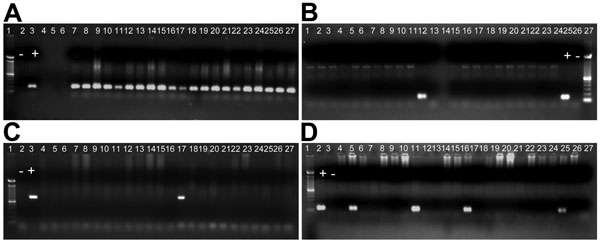Volume 21, Number 10—October 2015
Dispatch
Detection of Mixed Infections with Plasmodium spp. by PCR, India, 2014
Figure 2

Figure 2. Identification of Plasmodium spp. by nested PCR at 15 community health centers in 8 states in India to which malaria is endemic. A) Plasmodium falciparum (205-bp fragment). Lane 1, molecular mass marker; lane 2, negative (–) control; lane 3, positive (+) control; lanes 7−27, positive samples; lanes 5 and 6, negative samples. B) P. malariae (144-bp fragment). Lane 25, + control; lane 26, – control; lane 27, molecular mass marker; lane 12, positive sample; lanes 1–11, 13–24, negative samples. C) P. ovale (800-bp fragment). Lane 1, molecular mass marker; lane 2, – control; lane 3, + control; lane 17, positive sample; lanes 4–16, 18–27, negative samples. D) P. vivax (120-bp fragment). Lane 1, molecular mass marker; lane 2, + control; lane 3, – control; lanes 5, 11, 16, and 25, positive samples; lanes 4, 6–10, 12–15, 17–24, 26, and 27, negative samples.